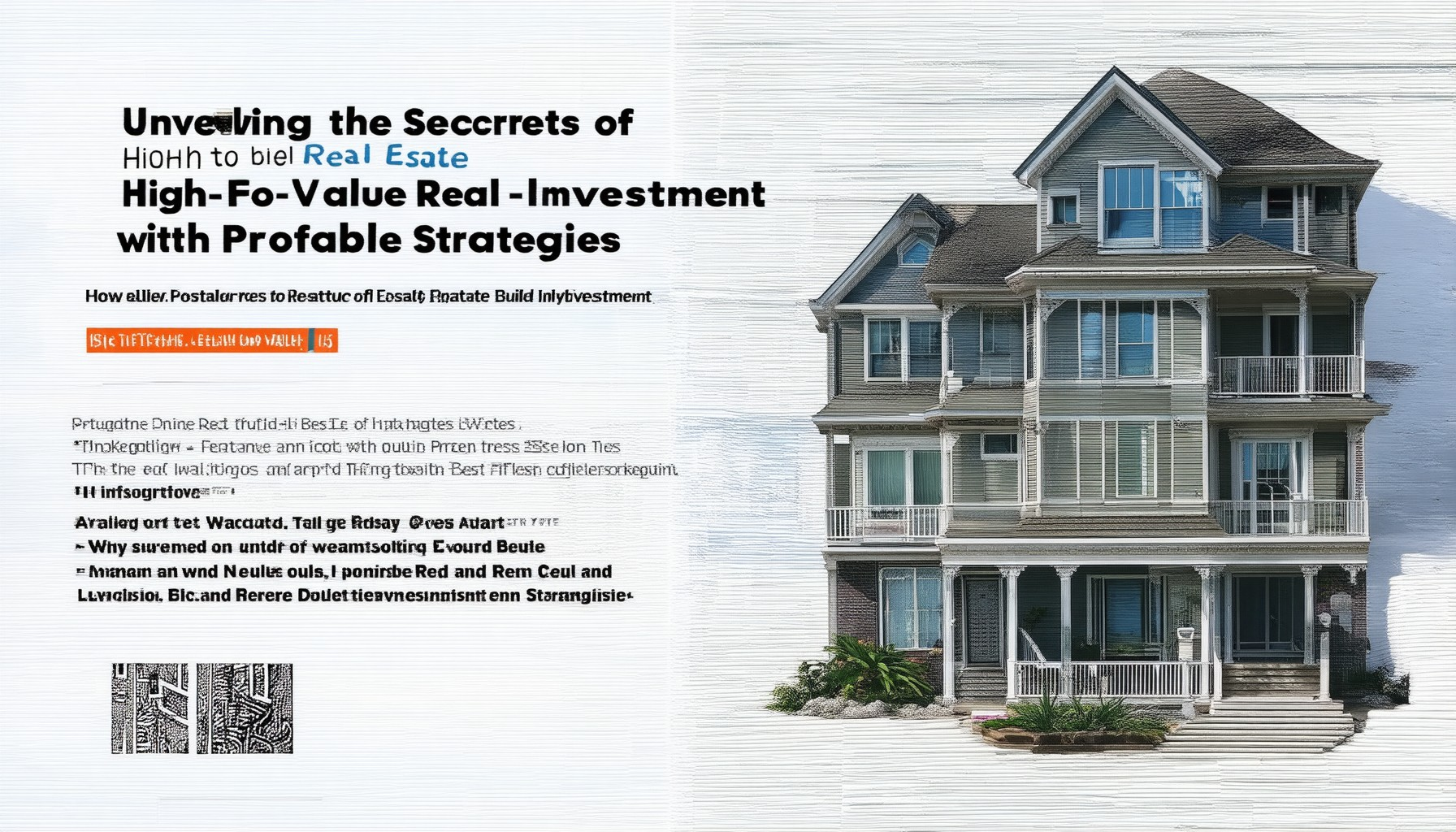Investing in high-value real estate has long been recognized as one of the most lucrative ways to build significant wealth. However, navigating the complexities of luxury real estate requires a strategic approach, meticulous planning, and a deep understanding of market dynamics. Whether you’re looking to diversify your portfolio with high-value properties or seeking proven strategies to maximize returns, this guide offers actionable insights and expert-backed approaches to help you achieve financial success. From mastering the 7% rule to unlocking the potential of advanced valuation methods, discover how even modest investments can yield extraordinary results. This comprehensive exploration of high-value real estate investment strategies equips you with the knowledge needed to make informed decisions, capitalize on emerging opportunities, and stand out in a competitive market.
Key Takeaways
– Master the 50% Rule: Learn how this guideline helps real estate investors assess profitability by ensuring operating expenses stay below half of gross income, optimizing cash flow potential.
– Adhere to the 28% Rule: Understand how this rule balances housing expenses against income, helping you maintain financial health and assess affordability for rental properties.
– Strategic $50k Investment: Discover the essential steps to maximize returns, from aligning goals and selecting the right property type to diversifying investments and seeking expert advice for informed decision-making.

The 7% Rule in Real Estate
The 7% rule is a fundamental guideline used by real estate investors to determine the maximum amount they can spend on property improvements or operational expenses without jeopardizing their profit margins. Here’s a breakdown of how it works:
- Definition: The 7% rule states that investors should allocate 7% of their cost basis (the price they paid for the property) to cover all permissible expenses.
- Calculation Example: If the cost basis of a property is $100,000, the investor can spend up to $7,000 on improvements or expenses without affecting their profit margin.
- Application: This rule is particularly useful for fixer-upper properties. For instance, if an investor purchases a property for $120,000, they can allocate 7% ($8,400) towards renovations or repairs.
- Profit Consideration: Exceeding this limit may reduce the profit margin. For example, if the property sells for $140,000, the profit would be $20,000, which is 12.5% of the cost basis, exceeding the 7% threshold.
- Market Variability: The effectiveness of the 7% rule can vary based on market conditions and property specifics, necessitating ongoing monitoring and adjustment.
This rule serves as a critical tool for managing expenses and ensuring profitability, complementing other investment strategies like the 2% rule for vacancy rates. By adhering to the 7% rule, investors can maintain a balance between spending and profitability, aligning with best practices in real estate investment.
What is the Most Profitable Real Estate Investment?
Investing in real estate can be highly rewarding, but success depends on location, property type, and market conditions. Here’s a breakdown of key factors to consider:
Key Factors Influencing Profitability
- Location: Proximity to job hubs, transportation, schools, and amenities boosts property values.
- Property Type: Residential, commercial, or industrial properties yield differently based on demand.
- Economic Trends: Growth in jobs, population, or infrastructure projects indicates high profit potential.
- Market Timing: Buying during a downcycle can lead to significant gains as the market rebounds.
High-Potential Property Types
- Single-Family Homes: Ideal for long-term appreciation, especially in growing neighborhoods.
- Condominiums: Great for investors seeking rental income or luxury properties.
- Apartment Complexes: Perfect for those looking to invest in rental housing markets.
- Commercial Properties: Retail spaces or office buildings in bustling areas can generate steady cash flow.
Economic Indicators to Monitor
- Unemployment Rate: Low rates indicate strong job market, driving demand for housing.
- Inflation Rates: Higher inflation may increase property values, but monitor borrowing costs.
- Mortgage Interest Rates: Lower rates reduce borrowing costs, increasing affordability.
Market Trends to Leverage
- Urban Renewal Areas: Emerging markets with potential for significant appreciation.
- Sustainable Developments: Properties in eco-friendly areas often see higher demand.
- Technology Hubs: Cities with tech companies experience rapid growth in housing demand.
Actionable Tips for Success
- Diversify Investments: Spread capital across different property types and regions.
- Research Thoroughly: Use tools like Real Estate Locations’ research tools for data analysis.
- Leverage Technology: Utilize platforms like Real Estate Locations’ tech resources for market insights.
- Stay Informed: Subscribe to our newsletter for updates on market trends.
Competitor Analysis
- Zillow
- Realtor.com
- Redfin
By combining these strategies, investors can identify high-potential opportunities and maximize their returns in the real estate market.

What Creates 90% of Millionaires?
Ninety percent of millionaires attribute their wealth primarily to a combination of strategic investments, inheritance, and smart financial decisions. Here are the key factors:
- Real Estate Investments: Owning and managing income-generating properties is one of the most common paths to building wealth. Real estate appreciates over time, offering significant returns.
- Inheritance: A significant portion of millionaires have inherited wealth, often from family businesses or investments, providing a financial foundation to build upon.
- Entrepreneurship: Many millionaires are entrepreneurs who started their own businesses, leveraging their skills and vision to create lucrative opportunities.
- Stock Market Investments: Consistent investing in stocks, mutual funds, and other financial instruments allows wealth to grow through compounding returns.
- Networking: Building relationships with wealthy individuals and accessing exclusive opportunities can accelerate wealth accumulation.
- Tax Efficiency: Utilizing tax shelters, deductions, and strategic planning helps retain more income, allowing it to grow faster.

What is the 50% Rule in Real Estate?
The 50% rule in real estate is a guideline used by investors to evaluate the potential profitability of rental properties. It suggests that a property’s operating expenses should not exceed 50% of its gross income. Here’s a breakdown of the key components:
Gross Income vs. Operating Expenses
- Gross Income : This refers to the total rent collected from tenants before subtracting any expenses.
- Operating Expenses : Includes costs like property taxes, insurance, utilities, maintenance, and management fees.
Why the 50% Rule Matters
- The rule helps determine if a property is generating enough revenue to cover its expenses, indicating positive cash flow.
- A lower percentage means higher profitability, while a higher percentage may indicate financial strain.
Considerations and Limitations
- The rule assumes ideal conditions and may not account for unexpected expenses.
- It’s a general guide and should be customized based on individual property characteristics.
How to Apply the 50% Rule
- Calculate gross income and compare it to operating expenses.
- Aim for a ratio below 50% for optimal performance.
Examples
- If a property generates $2000 in gross income and has $1000 in expenses, it meets the 50% rule.
- If expenses reach $1200, the rule is exceeded, potentially reducing profitability.
By understanding and applying the 50% rule, investors can make informed decisions about rental properties and their financial health.
What is the 28% Rule in Real Estate?
The 28% rule is a popular guideline used by many to determine what portion of their income should be allocated toward housing expenses. According to this rule:
- Housing Expense Limit: No more than 28% of your gross monthly income should be spent on housing-related expenses.
- Total Debt Limit: Combined housing expenses and all other debts (such as student loans, credit card debt, etc.) should not exceed 36% of your gross monthly income.
This rule is often used by lenders and financial advisors to help individuals assess their financial health and determine affordable housing options. It’s important to note that this is a general guideline and may vary depending on individual circumstances, financial goals, and local market conditions.
For more information on real estate locations and market trends, visit our website at Real Estate Locations .
Explore other real estate resources and guides at Zillow , Redfin , and Realtor.com .

Investing $50,000 in Real Estate: A Strategic Guide
Investing $50,000 in real estate can be a lucrative venture, but it requires careful planning and research. Here’s a structured approach to help you make informed decisions:
- Assess Investment Goals and Risk Tolerance
- Determine whether you aim for passive income, appreciation, or a combination of both.
- Consider your risk tolerance, as real estate investments can vary in stability and return.
- Choose the Right Property Type
- Rental Properties: Ideal for generating steady income. Look for areas with high demand and low vacancy rates. Tools like market analysis reports and local real estate agents can aid your search.
- House Hacking: Rent out part of your property while living in it. Suitable for those already owning a home in high-rent areas.
- REITs: A hands-off approach via stock investments, offering dividends and diversification benefits.
- Flipping Houses: Requires expertise and time. Not recommended if you’re employed full-time.
- Raw Land: High-risk, high-reward with potential for appreciation. Research growth potential thoroughly.
- Evaluate Funding Options
- Consider cash availability versus securing a mortgage. Investment property mortgages often require larger down payments and may have stricter criteria.
- Diversify Investments
- Spread $50,000 across multiple properties or combine with other assets like stocks or bonds for balanced risk.
- Consult Professionals
- Hire a real estate agent for property acquisition.
- Seek tax advice to leverage deductions and comply with regulations.
- Stay Informed and Network
- Read educational materials, attend seminars, and join investor groups for support and insights.
By following these steps, you can strategically allocate your $50,000 to maximize returns while minimizing risks. Remember to conduct thorough research and consider professional guidance to ensure informed decision-making.




0 Comments